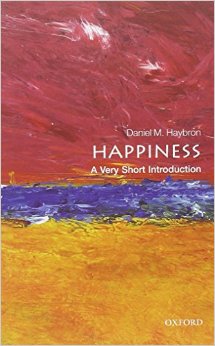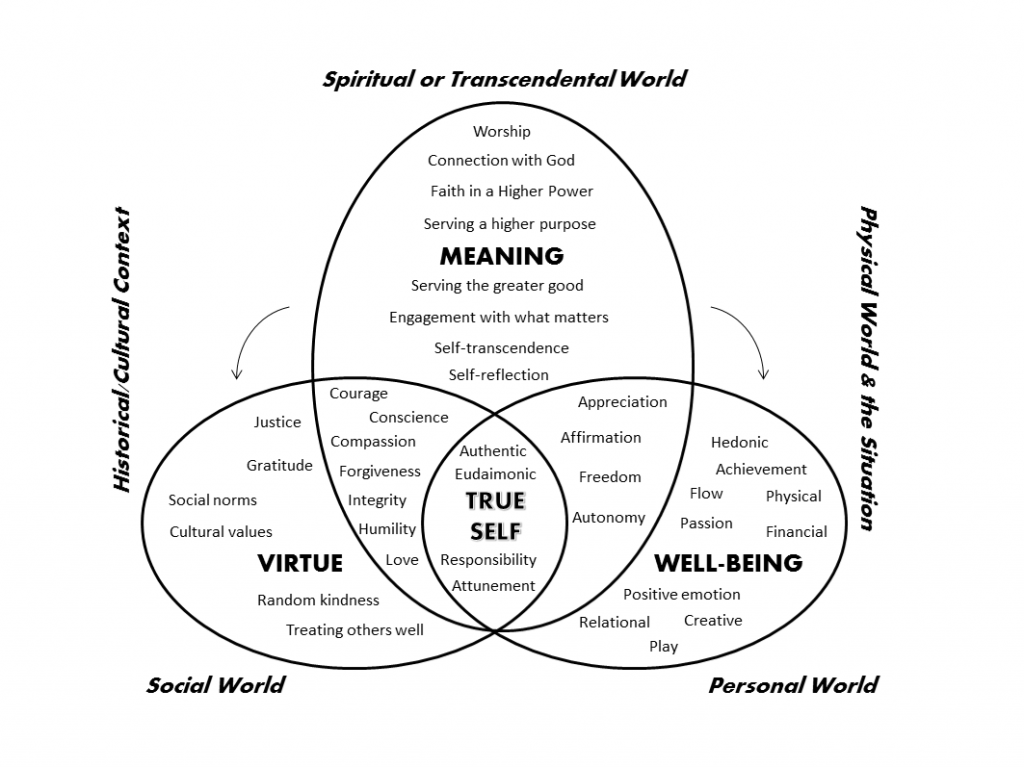
By Daniel M. Haybron
Oxford, UK: Oxford University Press, 2013. 168 pp.
ISBN 978-0199590605 $11.95
Reviewed by Paul T. P. Wong
Although the book is written, according to the author, for ordinary people, it does have something significant to offer to learned professionals, especially to positive psychology researchers and practitioners. In this review, I will highlight some important insights from the book that deserve special attention from positive psychology researchers.
The Importance of Context
Haybron begins with a warning of the danger of the wrong-headed pursuit of meaning from an individualistic perspective without consideration of the social context. He emphasizes, “happiness is not simply pursued at the individual level. How happy we are depends very strongly on the people around us and the kind of society we inhabit” (p. 13). Thus, one’s happiness score does not have much meaning without considering its immediate context and historical-cultural background.
A person in the midst of adversity with a score of 6 on a 7-point scale of life satisfaction probably is talking about a different kind of happiness than is another person who has the same score but has everything going well for her in life. In the former case, meaning making and benefit making justify the high level of life satisfaction.
The context can also refer to the larger story of the society or nation in which one lives. Suppose one lives in a totalitarian and coercive society with very few opportunities for meaningful engagement or the pursuit of one’s dreams: it is unlikely that one can successfully promote the kind of wellbeing identified in Seligman’s (2012) PERMA. The recent massive protest in Hong Kong clearly indicates that the young people there are very unhappy about the lack of democracy and universal suffrage.
The Attunement Dimension of Happiness
Haybron points out that it is instructive to recognize the three dimensions of happiness: endorsement (the pleasant-unpleasant dimension), engagement (vitality), and attunement (tranquility or equanimity). He describes attunement as “peace of mind, confidence, expansiveness… I would suggest that tranquility, or something like it, is the cornerstone of happiness” (p. 22).
As a Chinese person well acquainted with the teachings of Taoism and Buddhism on happiness (Wong, in press), I agree totally with Haybron that feeling comfortable in one’s skin or feeling perfectly at home in one’s element is perhaps the most important dimension of happiness. Unfortunately, most of the existing measurements of happiness do not capture this dimension.
Attunement also represents Haybron’s emotional state theory of wellbeing, which is broader than happiness. Attunement is a mental state characterised by the kind of emotional evaluation of one’s life of being at peace with one’s self, as described by Matthieu Ricard, a leading Buddhist thinker on happiness: “By ‘happiness’ I mean here a deep sense of flourishing that arises from an exceptionally healthy mind. This is not a mere pleasurable feeling, a fleeting emotion, or a mood, but an optimal state of being” (quoted in Haybron, p. 29).
Haybron’s concept of attunement is similar to Siegel’s (2007) mindfulness-based attunement and Wong’s (2012) resting mental state characterized by mindful awareness. Recently, Wong (2014a, b) has elaborated the concept of attunement to characterize a highly developed and integrated person, who is at peace with herself, with others, and with the world, because she has fulfilled the true self that involves all three worlds of being – personal, social, and spiritual.
Figure 1 below represents my meaning-centered approach to a good life, which clearly reflects Haybron’s influence.
The main difference between Haybron and me is that I include the supernatural component as an essential part of my conception of meaning. It is worth noting that Haybron started his analysis with a focus on happiness and I started my search for a good life focusing on meaning, but both of us came to the same conclusion: we both accept Aristotle’s teleological view of eudaimonia and emphasize the cultivation of virtue and meaning as the foundation of happiness and wellbeing. Such a view recognizes both nature-fulfillment of human excellences and self- fulfillment of individual potentials.
An attuned person fits perfectly the self-portrait of Matthieu Ricard, and can also be applied to describe Lao Tse, the Dalai Lama and Desmond Tutu. In other words, the concept of attunement is potentially very important in capturing the characteristics of a fully functioning person, who has integrated and harmonized his body, mind, and soul and who has also fulfilled his or her true self in all three realms of being.
Regarding the three dimensions of happiness, Haybron is probably correct in suggesting that, “If we had to limit ourselves to a single question, it might take the form of asking people to rate their emotional conditions on a scale from say, ‘depressed and stressed’ to ‘joyful and relaxed’” (p. 44). When a person’s resting state is calm and tranquil rather than anxious, this person is more likely to enjoy mental and physical wellbeing. As indicated in Figure 1, attunement, along with eudaimonia and authenticity, can be regarded as one of the three cornerstones of a good life.
Another significant insight from Haybron is that, “a large portion of psychological well-being is unconscious” (p. 26). The unconscious state of wellbeing, maybe called “mood propensity” (p. 27), is a mental state or psychological condition that either predisposes people to happiness or to distress. It suggests that attunement cannot be achieved without resolving the traumatic or attachment issues from childhood that reside in the unconscious region. Thus, the concept of attunement greatly expands our understanding of the nature and conditions of happiness.
A Meaning-Centered Approach to How to Live a Good Life
To me, the greatest contribution of the book may be Haybron’s meaning hypothesis of a good life. He proposes that a good life consists of three components: wellbeing, virtue, and meaning. Meaning is the key because it also influences wellbeing and virtue, as schematized in Figure 1, and described in the following paragraph:
I cannot confidently enumerate all the values that factor into a good life. But I have suggested that happiness is part, but not the whole, of human well-being. Beyond well-being, it is still more important to act well: virtue is our first priority in life. Leading a meaningful life contributes both to well-being and to virtue. (p. 106)
Well-Being
Wellbeing is broader than happiness as most people understand it, because it is concerned with what ultimately benefits a person rather than how positive one feels at any moment. “Well- being… is ultimately a matter of value: what is good for us?” (pp. 77-78). Seligman’s (2012) PERMA theory would be considered a “list theory” of wellbeing, because it consists of a list of five conditions necessary for wellbeing; the problem with the list approach is that what is included in the list could be arbitrary. I could justifiably add resilience to the list.
Haybron favours Aristotle’s eudaimonic theory of wellbeing. What ultimately benefits a person is “displaying the excellences characteristic of human beings… rooted in universals of human nature” (p. 82). Haybron’s neo-Aristotelian position proposes that eudaimonia results not only from nature-fulfillment (Aristotle) but also from self-fulfillment (John Stuart Mill). The latter refers to fully developing one’s unique potential or true self.
In his justly famed essay on the value of individuality in On Liberty, British philosopher John Stuart Mill portrayed a more modern, individualized ideal, which we might call self-fulfilment: living in accordance with who you are—the self. On the ideal of self-fulfillment, well-being is a matter of your individual personality, however eccentric that might be. (p. 87)
This neo-Aristotlean position of embracing both nature-fulfillment and self-fulfillment is very similar to my existentially oriented meaning-centered approach to a good life, as shown in Figure 1.
Virtue
Virtue is another component of a good life. A good life is not only good for the person (wellbeing), but also intrinsically good. It is a life that will pass the “death bed test” of having no regrets about one’s life. It will also pass the “eulogy test” because others can rightly praise the deceased as a good and decent human being, who has treated others in a kind and admirable way.
Aristotle’s eudaimonic theory of wellbeing is a virtue-based theory; to lead a virtuous life is to excel in uniquely human capabilities. Thus, a life devoted to the pursuit of virtue represents the deepest, fullest happiness because it fulfills its uniquely human nature.
Haybron is absolutely correct in stating that virtue trumps all other values. Virtue, including its moral aspect, is an indispensable dimension of the good life because virtue is not only good in its own right but also benefits others and society. Acting well involves doing what is moral, decent, and responsible. Acting badly would not make one’s life worthy of admiration, even when one is hugely successful as a drug dealer or gangster. Aristotle’s theory of virtue ethics stands in sharp contrast to the value-neutral stance of positive psychology (Seligman, 2002). Haybron states very well that, “One should not be an asshole in the pursuit of happiness” (p. 97). It is worth noting that Viktor Frankl (1985) also recognizes the need for objective values as the basis for the subjective experience of felt sense of meaning in life.
While what constitutes subjective wellbeing is up to each individual to decide, virtue requires a relational and objective criterion, as proposed by Aristotle. Whether a certain behavior or certain individual is deemed virtuous is always based on some kind of social norm regarding one’s impact on other people and society. That is why virtue exists primarily in the social realm.
Meaning
If virtue has to do with fulfilling what is excellent in human nature, then meaning has to do with the process of fulfilling what is excellent in one’s unique nature as an individual. One is truly happy when one does what one is best at and what one loves doing. The accent is on the process rather than on the destination.
The defining characteristic of meaning, according to Haybron, is appreciative engagement with the things and people that really matter. A good life is not just living well by acting well, but also by connecting with what really matters, as emphasized by Haybron:
“Another crucial part of living well has to do with meaning: very roughly, connecting with people and things that matter. We want not just to be happy, or good. We also want to pass our lives in meaningful, worthwhile pursuits.” (p. 97)
Meaning impacts wellbeing not only through the route of virtue but also through the activities of engagement. “The most meaningful activities involve appreciative engagement, or connection with people and things that matter. And emotional fulfilment might arise only through this sort of activity” (p. 71). More importantly, happiness also arises from authenticity as a person: “To be authentically happy, your happiness must be grounded in your life, and reflect who you truly are” (p. 87).
Haybron is correct in pointing out that authenticity will receive more research attention in coming decades because it counteracts the prevailing componential approach of focusing on actions or emotions, which cannot fully represent a person’s true self. This sounds like music to me, because I have been advocating exactly the same in my meaning-centered approach (Wong, 2007, 2014a,b).
To value something is to assume personal responsibility for deciding on one’s core values and appreciating what really matters, what is really worth pursuing. Thus, to be engaged in what matters is predicated on what one appreciates or values.
Following Frankl (1985), and Pattakos and Dundon (2015), an appreciative attitude can be elevated to affirming the intrinsic meaning and value of life and embracing life in totality. Such a defiant attitude, an attitude of appreciation and affirmation of life regardless of circumstances, provides the grounding for appreciating what really matters.
Conclusion
At the end of the book Haybron asks a rhetorical question about happiness and answers it with an emphasis on virtue and meaning:
Suppose, then, that you live as wisely as can reasonably be expected. Will you be happy? Maybe, but that’s only partly in your control. But the chances are excellent that you’ll have a life well lived, and well worth living. A good life. (p. 127)
The good thing about the meaning hypothesis is that the essentials of a good life are accessible and available to most people. “Life is hard, yes. But it is also, for most, good” (p. 9). According to Haybron’s relevant and widely applicable model, “the essentials of a good life are available even to people who don’t own much—and even…to those who never manage to be happy” (p. 9). His essentials are in many ways similar to Metz’s (2013) fundamentals of meaning in life. He provides a very valuable road map to all those seeking a good life, not just the elite good. Haybron comes to about the same conclusion as Heintzelman and King (2014), that life, for most people, is pretty meaningful: but Haybron advances much more compelling reasons.
In another departure from positive psychology’s emphasis on positive interventions focusing on behaviors and emotions, Haybron takes a person-centered approach and supports Aristotle’s emphasis on self-cultivation as a way to appreciate and connect with what really matters:
The world’s value does not simply depend on our whims, but is something we discover. We remind ourselves to keep our eye on the ball, not letting our desires become detached from the things that really matter. And we educate and cultivate ourselves, in part so that we may better appreciate the worth of things…to be an appreciator, as we might call it. (p. 103)
In addition to his penetrating analysis and illuminating insights, Haybron also offers a sound methodological critique on happiness measures. He is right on the money in questioning “the hypothesis of near-universal happiness” (p. 49), as well as the implausibly high ratings of self- reported happiness, which scream “overwhelmingly happy society” (p. 50). He marshals a great deal of evidence to support his critique. The take home message for researchers is that if we want to advance the scientific knowledge of happiness or meaning, we need to go beyond the over- reliance on quick and dirty self-ratings, which yield a greatly inflated state of happiness; we need to devote more effort to do the hard work of achieving a deeper understanding of the construct of happiness, as he has done in this book. Only then can we develop more holistic and realistic ways to measure happiness.
In sum, Haybron begins with a thorough analysis of happiness as a positive emotion, but ends with a much broadened and multifaceted conceptual framework of happiness—a meaning- centered approach to a good life, in which meaning is of the utmost importance. I highly recommend this little treasure for all positive psychology researchers and practitioners, because this treasure box overflows with valuable ideas.
References
- Frankl, V. E. (1985). Man’s search for meaning (Revised and updated ed.). New York, NY: Washington Square Press.
- Heintzelman, S. J., & King, L. A. (2014). Life is pretty meaningful. American Psychologist, 69, 561-574. doi:10.1093/acprof:oso/9780199599318.001.0001
- Metz, T. (2013). Meaning in life. Oxford, UK: Oxford University Press. doi:10.1093/acprof:oso/9780199599318.001.0001
- Pattakos, A., & Dundon, E. (2015). The OPA! way: Finding joy & meaning in everyday life & work. Dallas, TX: BenBella Books.
- Seligman, M. E. P. (2002). Authentic happiness: Using the new positive psychology to realize your potential for lasting fulfillment. New York, NY: Free Press.
- Seligman, M. E. P. (2011). Flourish: A visionary new understanding of happiness and well-being. New York, NY: Free Press.
- Siegel, D. J. (2007). The mindful brain: Reflection and attunement in the cultivation of well-being. New York, NY: Norton.
- Wong, P. T. P. (2007). Introduction: A quiet positive revolution. In P. T. P. Wong, L. C. J. Wong, M. J. McDonald, & D. W. Klaassen (Eds.), The positive psychology of meaning and spirituality: Selected papers from meaning conferences (pp. 1-8). Abbotsford, BC: INPM Press.
- Wong, P. T. P. (2012). Toward a dual-systems model of what makes life worth living. In P. T. P. Wong (Ed.), The human quest for meaning: Theories, research, and applications (2nd ed., pp. 3-22). New York, NY: Routledge.
- Wong, P. T. P. (2014a). A journey of personal development: Self-discovery, healing, and growth. A course for the Toronto Meaningful Living Meetup Group, Toronto, Canada. Dr. Paul Wong. Retrieved from http://www.drpaulwong.com/a-journey-of-personal-development-self-discovery-healing-and-growth/
- Wong, P. T. P. (2014b, July). A seeker’s guide to meaningful living. A keynote address presented at the First Congress on the Construction of Personal Meaning in Vancouver, BC, Canada.
- Wong, P. T. P. (in press). Chinese positive psychology.
Cite
Published as Wong, P. T. P. (2014). From attunement to a meaning-centred good life: Book review of Daniel Haybron’s Happiness: A very short introduction. International Journal of Wellbeing, 4(2), 100-105. doi:10.5502/ijw.v4i2.5


 Meaning Conference 2025 will be the INPM’s first in-person conference with a virtual option after the pandemic.
Meaning Conference 2025 will be the INPM’s first in-person conference with a virtual option after the pandemic.